Delving into the world of horses, one can’t help but be fascinated by their grace and strength. A key component to these majestic creatures’ athleticism and beauty lies in their complex anatomy. To truly appreciate the marvel that is a horse, understanding the skeletal framework that supports and protects them is essential. So, how many bones does a horse have? Let’s unravel this mystery through the lens of equine anatomy.
- Horses typically possess around 205 bones in their skeleton, although this number can vary slightly among different breeds.
- The horse skeletal system plays a pivotal role in locomotion, performance, and protection of vital organs.
- Equine bone count is not just a matter of quantity but also intricately related to the animal’s overall health and functionality.
Understanding the Complex Systems of Horse Anatomy
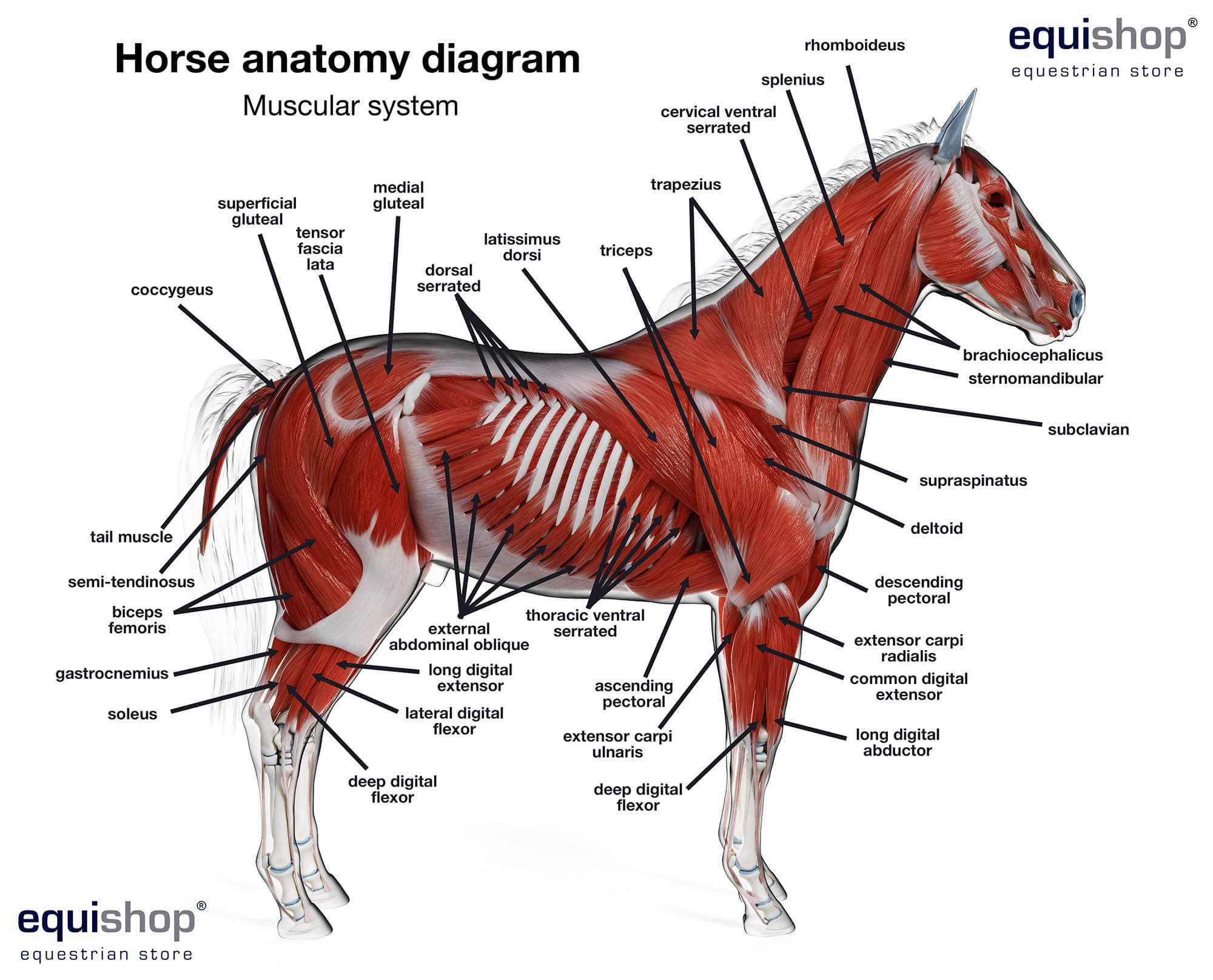
Exploring the various systems that make up horse anatomy reveals a sophisticated structure tailored for high performance and survival. These systems, encompassing muscles, tendons, ligaments, and organs, are harmoniously interconnected to support the horse’s remarkable physical abilities. An in-depth understanding of these components is not only fascinating but also critical for providing optimal care for these noble creatures.
Understanding Equine Musculature
The horse’s muscular system, essential for movement and strength, consists of different muscle types that enable a wide range of actions. These muscle groups are crucial for the animal’s ability to perform in equestrian sports and everyday tasks.
- Skeletal Muscle: This muscle type is responsible for voluntary movements and is vital for a horse’s physical capabilities in various disciplines.
- Cardiac Muscle: The heart’s muscle, it plays a key role in maintaining endurance and supporting the demands of athletic activity.
- Smooth Muscle: Found in the internal organs, it regulates involuntary processes like digestion and circulation.
Circulatory Dynamics in Equines
The sophisticated circulatory system of a horse is designed to support its muscular strength and high metabolic needs. The heart and blood vessels work in concert to distribute essential nutrients and oxygen to sustain the horse’s health and stamina.
Efficient Respiration and Digestion in Horses
The respiratory and digestive systems in horses are adept at meeting the energy requirements necessitated by their size and activity levels. These systems ensure that horses can maintain their energy through efficient oxygen uptake and food metabolism, critical for their performance and well-being.
The Nervous System: Coordination and Response
Horses rely on a sophisticated nervous system for movement coordination, sensory processing, and cognitive function. This intricate network plays a central role in their interaction with the environment and ability to respond effectively to external stimuli.
Protective and Sensory Functions of the Integumentary System
The integumentary system, which includes the skin, hair, and hooves, provides protection, thermoregulation, and sensory perception. It is vital for a horse’s interaction with its environment and plays a significant role in overall health.
Fostering Equine Lineages
The reproductive system in horses is designed to ensure the continuity of the species. An intricate understanding of this system is instrumental in breeding practices aimed at preserving and enhancing equine lineages.
Recognizing the specialized roles of each anatomical system enriches our knowledge and ability to care for equines. The comprehensive study of horse anatomy sheds light on the complexity and resilience of these animals, underscoring their historical and ongoing significance in human society.
Insights into the Horse Skeletal Structure
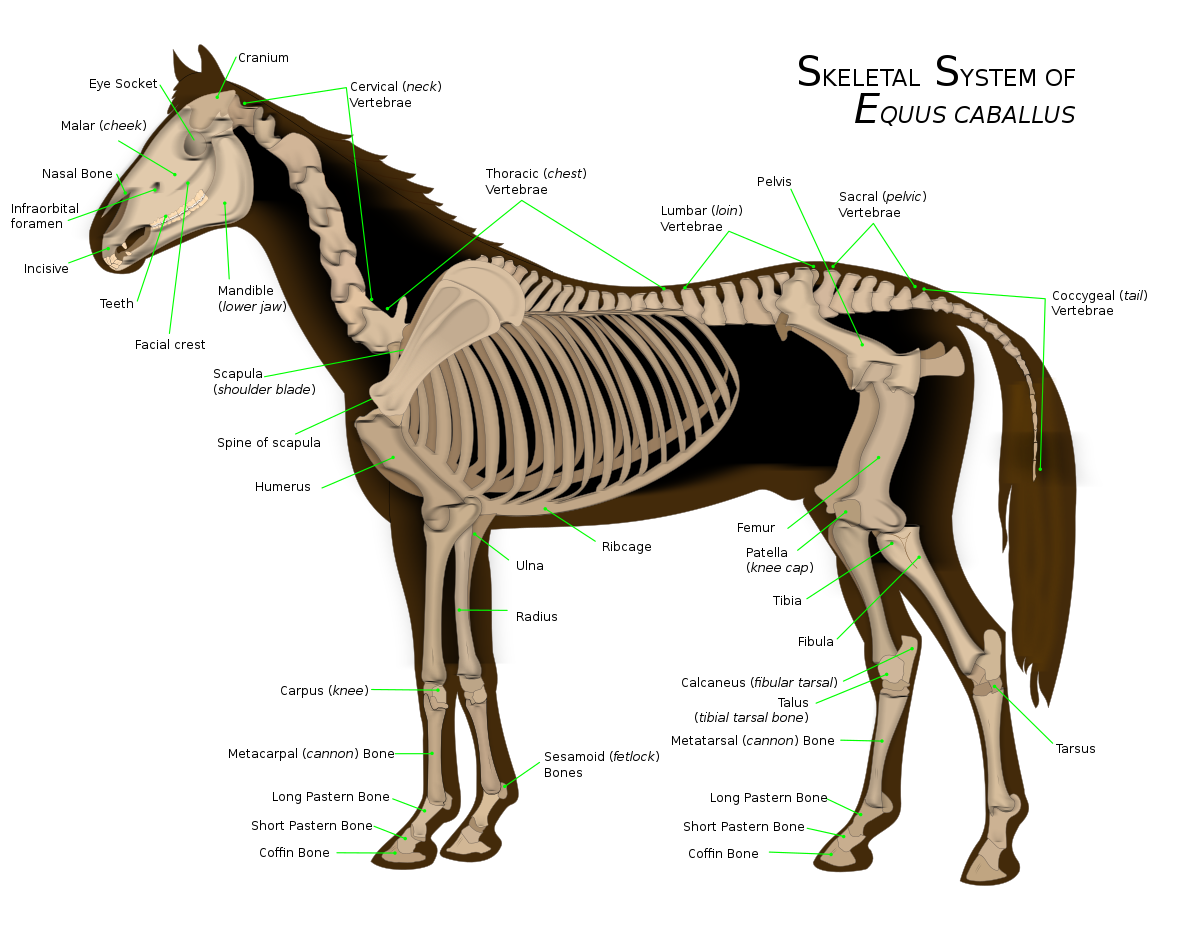
The horse skeleton is a dynamic and intricate structure integral to the animal’s movement and survival. It not only forms the framework for the horse’s muscular physique but also safeguards the vital internal organs. Continuously remodeling to adapt to growth and healing, the skeletal system’s complexity requires thorough understanding by those responsible for equine health and training.
Detailed Composition of the Horse Skeleton
The evolution of the horse has led to a skeletal system that is a testament to both strength and efficiency, enabling swift and enduring movement. Every bone, from the diminutive bones within the ear to the stout femur, is specialized for distinct functions, contributing to the horse’s agility and organ protection.
- The horse’s central framework is formed by the axial skeleton, which includes the skull, spine, ribs, and sternum.
- The appendicular skeleton comprises the limbs, which bear the horse’s substantial weight and facilitate rapid motion.
Unique Features of the Equine Skeletal Design
Distinguishing features separate the horse’s skeletal anatomy from that of other mammals. The elongated equine skull with a set of teeth adapted for grazing and a spine that combines flexibility with strength underline the horse’s unique build.
- Skull: A composite of fused bones that provide a solid case for the brain and sensory organs.
- Spine: A versatile structure that enables the horse’s body to support various movements.
Diversity in Bone Structure Among Equines
There are subtle differences in bone structure across horse breeds, influenced by selective breeding to enhance traits like speed or dexterity. These distinctions can alter the horse’s physical capabilities and contribute to the uniqueness of each breed.
Equine Limb Anatomy and Movement
A horse’s limbs are fundamental to its locomotive ability, crafted to endure the forces of speed and leaping. The bones in the forelimbs and hindlimbs are evolutionary adaptations that support vigorous activities while mitigating injury risks.
- Forelimbs: Include bones such as the humerus, radius, ulna, and the bones forming the knee, metacarpal region, and phalanges.
- Hindlimbs: Comprise the femur, tibia, fibula, and the bones of the hock, metatarsal area, and phalanges.
Protection and Support: Additional Roles of the Skeleton
The horse’s skeletal system extends beyond mobility, providing essential protection and support. For example, the ribcage not only facilitates breathing but also acts as armor for the thoracic cavity’s organs. The skull and spine are fundamental in safeguarding the nervous system and maintaining the body’s upright posture.
- Ribcage: Typically includes 18 pairs of ribs, encasing thoracic organs and assisting respiratory functions.
- Skull and Spine: Enclose the central nervous system and form the basis for head and neck structure.
Understanding the horse’s anatomy, particularly the skeletal system, is not just an academic pursuit but crucial for their care and management. From the equine bone count to the individual bone structures, the skeletal system is a fascinating and essential aspect of horse anatomy.
Delving Deeper into Equine Skeletal Adaptations
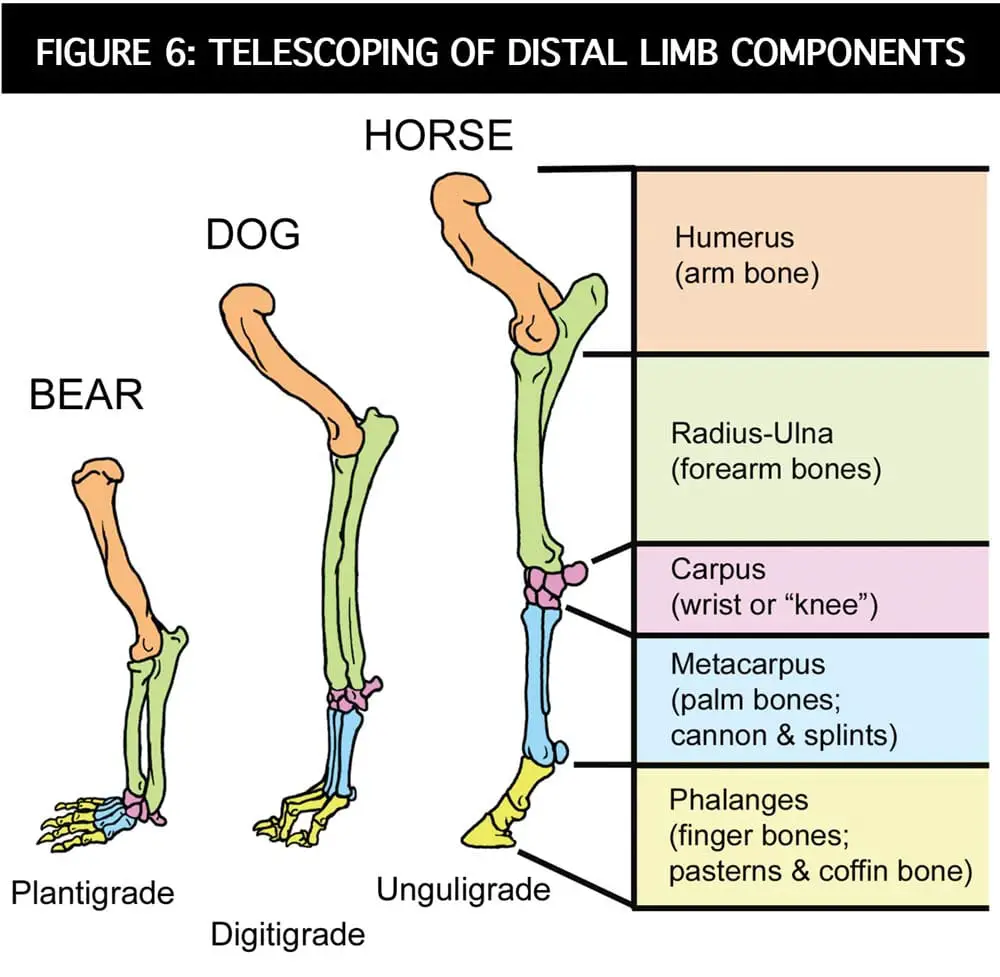
The architecture of a horse’s body is underpinned by a sturdy yet intricately designed skeletal system, which is central to the animal’s support, mobility, and organ protection. The unique shape and robustness of their bones are indicative of the high-performance demands placed on these creatures throughout their evolution.
Specialized Bone Types in Horses
A detailed investigation into the horse bone structure reveals an array of bone types each tailored to enhance specific functions. These varying bone classifications play critical roles in the horse’s ability to perform a variety of tasks with both strength and grace.
- Long bones, such as those in the legs, provide leverage and contribute to the horse’s extensive stride.
- Short bones located in joints like the knee and hock offer shock absorption and joint stability.
- The broad, flat bones such as the pelvis and ribs facilitate muscle attachment and organ protection.
Comparing Horse and Human Skeletal Structures
While examining the skeletal systems of horses and humans, we find that both start with more bones that fuse as they mature. The resulting adult bone count is similar, with horses generally having approximately one bone less than humans, reflecting each species’ unique structural requirements and evolutionary paths. These distinctions illustrate how the skeletal system has evolved to support different functions, such as weight-bearing in horses versus the fine motor skills seen in humans.
Adaptations in Equine and Human Skeletons
The skeletons of horses and humans have evolved features that enable them to thrive in their respective environments. Horses have developed dense limb bones for endurance and load-bearing, while humans have a skeleton that supports an upright, two-legged stance. These adaptive differences are not only fascinating from an evolutionary standpoint but also provide crucial insights for healthcare professionals in both veterinary and medical fields.
These comparative studies underscore the significance of the evolutionary journey in shaping each species’ skeletal features. For instance, the horse’s limb bones have evolved for fleetness, whereas human hands have developed for intricate tasks and tool manipulation. By understanding these evolutionary distinctions, we can better appreciate the anatomical intricacies of both horses and humans.
Evolutionary Highlights in Equine Skeletal Development
The horse’s evolution showcases a series of skeletal adaptations aimed at optimizing the animal for its environment. From longer limb bones aiding in expansive strides to solid hooves crafted for enduring high-impact motion, these evolutionary developments demonstrate nature’s fine-tuning of the horse for performance and survival.
- The lengthening of bones in the limbs has been crucial for achieving greater strides and speed.
- The hoof structure has evolved to be resilient, supporting the horse’s weight during vigorous activities.
- Adaptive joint designs, like the hip’s ball-and-socket, contribute to the powerful drive seen in a gallop.
Each evolutionary trait within the horse’s skeletal system has been shaped over time to fulfill the needs of these animals, allowing them to excel in various terrains and activities. The study of these skeletal features deepens our understanding of horse bone structure and its importance in the context of equine health and capabilities.
Exploring the Vitality of the Horse Skeletal System in Equine Function
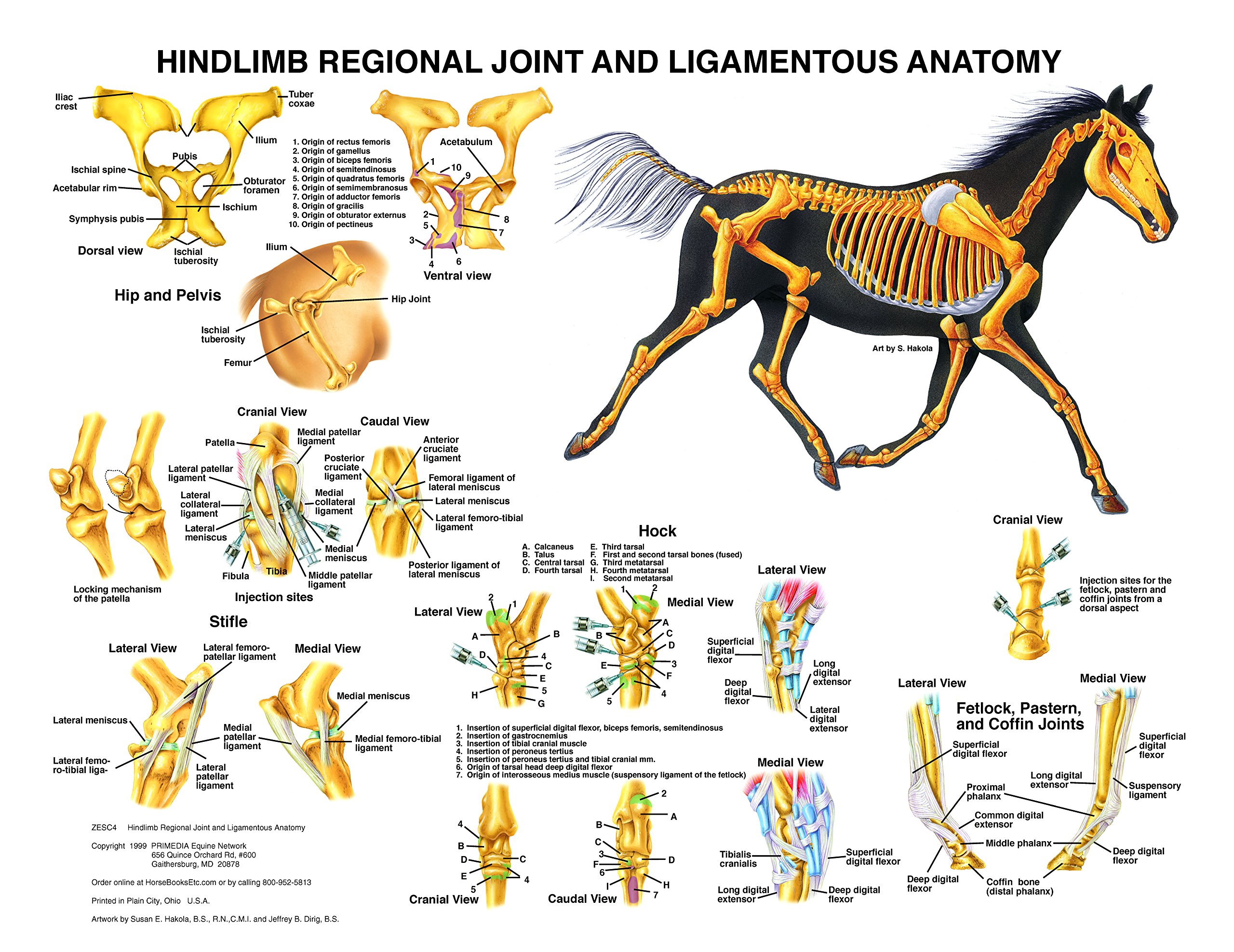
The resilience and versatility of the horse skeletal system are fundamental to the horse’s ability to perform a multitude of tasks, from carrying a rider to sprinting across a field. Its durability and strength support the considerable mass of these animals, while its sophisticated design enables a fluidity of motion essential for speed and agility.
Joint and Bone Health in Equine Movement
The health of joints within the skeletal anatomy of horses is vital for the smooth articulation necessary for movement. The synovial joints, surrounded by a tough, flexible capsule and lined with cartilage, cushion the ends of bones, reducing friction and wear. To maintain this health, equine bone and joint supplements provide essential nutrients that support the repair and resilience of these critical structures.
Conformation: The Skeletal Blueprint for Equine Athletes
The physical structure of the horse significantly influences its performance and propensity for certain activities. A horse with excellent skeletal conformation is more likely to excel in athletic pursuits and have a longer career. The relationship between bone structure and performance is central for breeders, trainers, and veterinarians, as they strive to optimize the physical capabilities of these animals.
- Angular limb deformities can affect a horse’s gait and lead to joint stress.
- A strong back is crucial for weight-bearing and effective rider communication.
- Proper hoof and pastern alignment contributes to better shock absorption and thrust.
Bone Remodeling: The Horse Skeletal System’s Response to Stress
Equine bones are dynamic, continuously remodeling in response to external forces. This process strengthens areas that experience regular stress and resorbs bone in less stressed regions. Bone density and structure adapt to the loads they bear, a principle observable in the robust limbs of a horse.
- Osteoblasts create new bone tissue where needed.
- Osteoclasts remove bone tissue from areas where it is less necessary.
- Appropriate training and conditioning can stimulate healthy bone remodeling.
Equine Osteology: A Deeper Dive into Bone Types and Functions
An investigation into equine osteology reveals various bone types within the horse skeletal system, each serving distinct functions. The sesamoid bones, small nodules embedded within tendons, act as pulleys increasing the tendons’ mechanical advantage, while irregular bones such as the vertebrae protect the spinal cord and support muscular attachments.
- Irregular bones offer protection and structural support.
- Sesamoid bones enhance tendon function.
- Flat bones provide a broad surface for muscle attachment and organ protection.
The horse skeletal system is a testament to nature’s engineering, enabling these animals to fulfill their roles as companions, workers, and athletes. Its diverse range of bone types and adaptive capabilities are crucial for the horse’s survival and efficacy in various settings, making it a subject of ongoing study for enhancing equine health and performance.
Functional Adaptations in Equine Anatomy
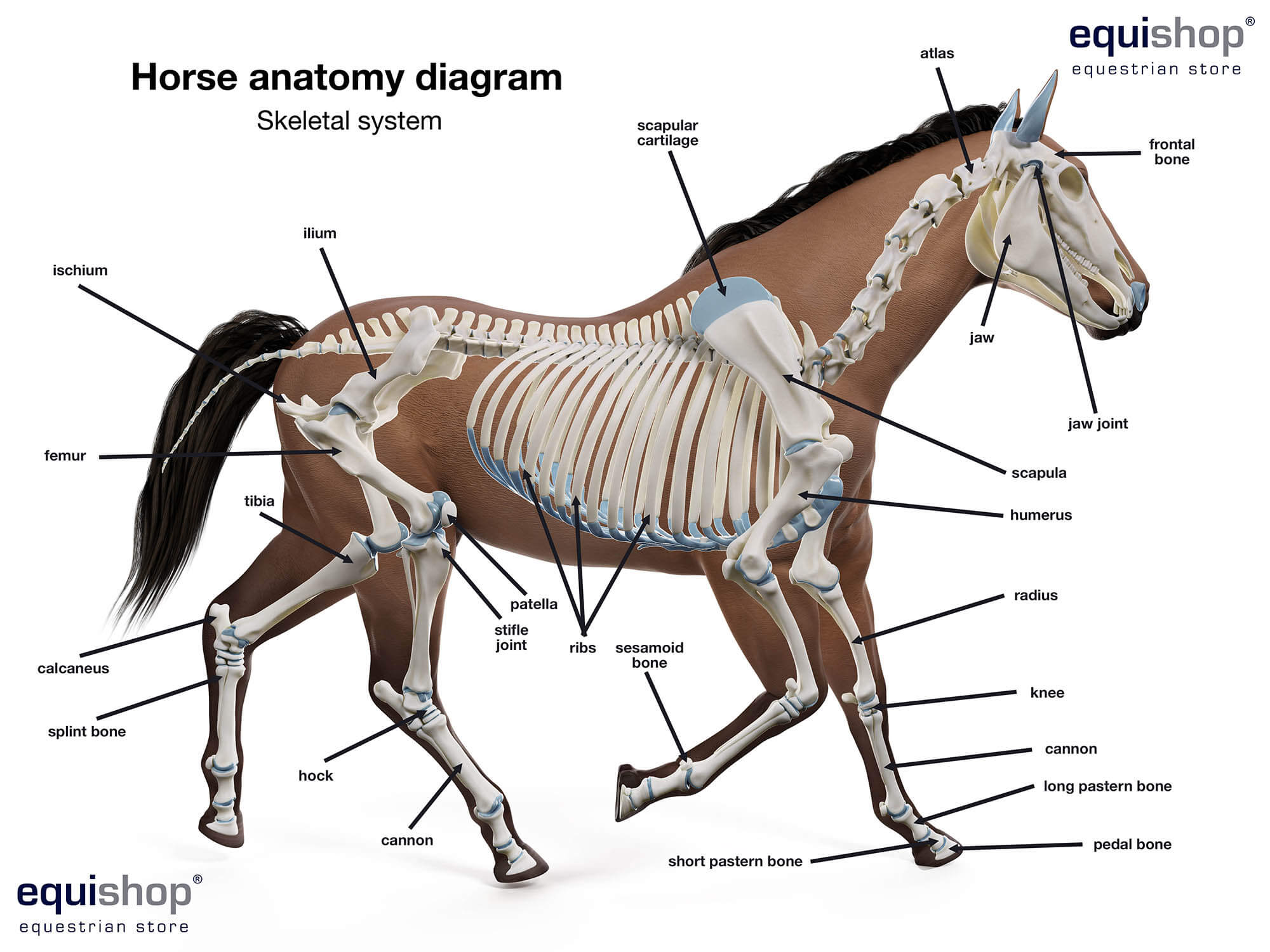
The distinct characteristics of equine anatomy contribute to the horse’s remarkable physical prowess. These specialized adaptations, which include the unique muscular and tendon structures supporting the absence of collarbones, are essential for their strength, dexterity, and evolutionary success. Understanding these features provides valuable insight into their natural abilities and the tailored care necessary for their well-being.
Scapular Support System in Horses
Horses exhibit a notable capacity for shoulder movement and bearing weight without the presence of collarbones. This capability is enabled by the scapula’s musculotendinous attachments, which afford flexibility and stability. The resulting muscular sling supports the forelimbs’ load and mitigates shocks from movement, aiding in the horse’s overall agility and enabling feats like high jumps and rapid directional changes.
Growth Dynamics in Equine Bones
The growth of a horse’s skeletal structure is a delicate interplay between dietary input, hereditary factors, and the environment. Adequate mineral intake is critical for the formation of a durable skeletal frame. During the growth phase, the long bones’ growth plates are highly active and susceptible, necessitating considerate care to prevent damage and ensure correct growth trajectories as horses mature.
Design and Functionality of Equine Limbs
The evolutionary refinement of the horse’s limbs reflects a balance between strength and mobility. The front legs shoulder the majority of the animal’s mass and manage the impact of movement, while the hindquarters deliver the power necessary for acceleration and jumping. The limbs’ anatomy, particularly the cannon bone, is fine-tuned for effective weight support and energy utilization during motion.
Strategies Against Bone Disease in Horses
Equine bone health extends beyond mineral supplementation to the prevention of metabolic diseases such as osteoporosis. Particularly vulnerable are young horses and those undergoing intensive training. Proactive management, including regular health assessments, nutrition suited to the horse’s developmental stage, and suitable exercise plans, is essential in preserving bone health and extending the horse’s active life.
Essential Hoof Maintenance in Horse Care
Hoof integrity is a fundamental aspect of horse health, with the hooves serving a critical role in dissipating movement-generated energy and carrying weight. Attentive hoof management, encompassing regular maintenance and protective measures like shoeing when needed, is crucial for the animal’s overall functionality. The multiple components of the hoof, including the wall, sole, and frog, collectively contribute to the horse’s stability and capacity for motion.
These adaptations within equine anatomy highlight the importance of specialized care for horses. The evolutionary advancements seen in their skeletal and muscular systems enable them to thrive in their roles, necessitating a holistic approach to their health and upkeep. Understanding and addressing each anatomical aspect, from scapular dynamics to hoof care, is vital for fostering the longevity and vitality of these esteemed animals.
Insights into Equine and Comparative Skeletal Adaptations
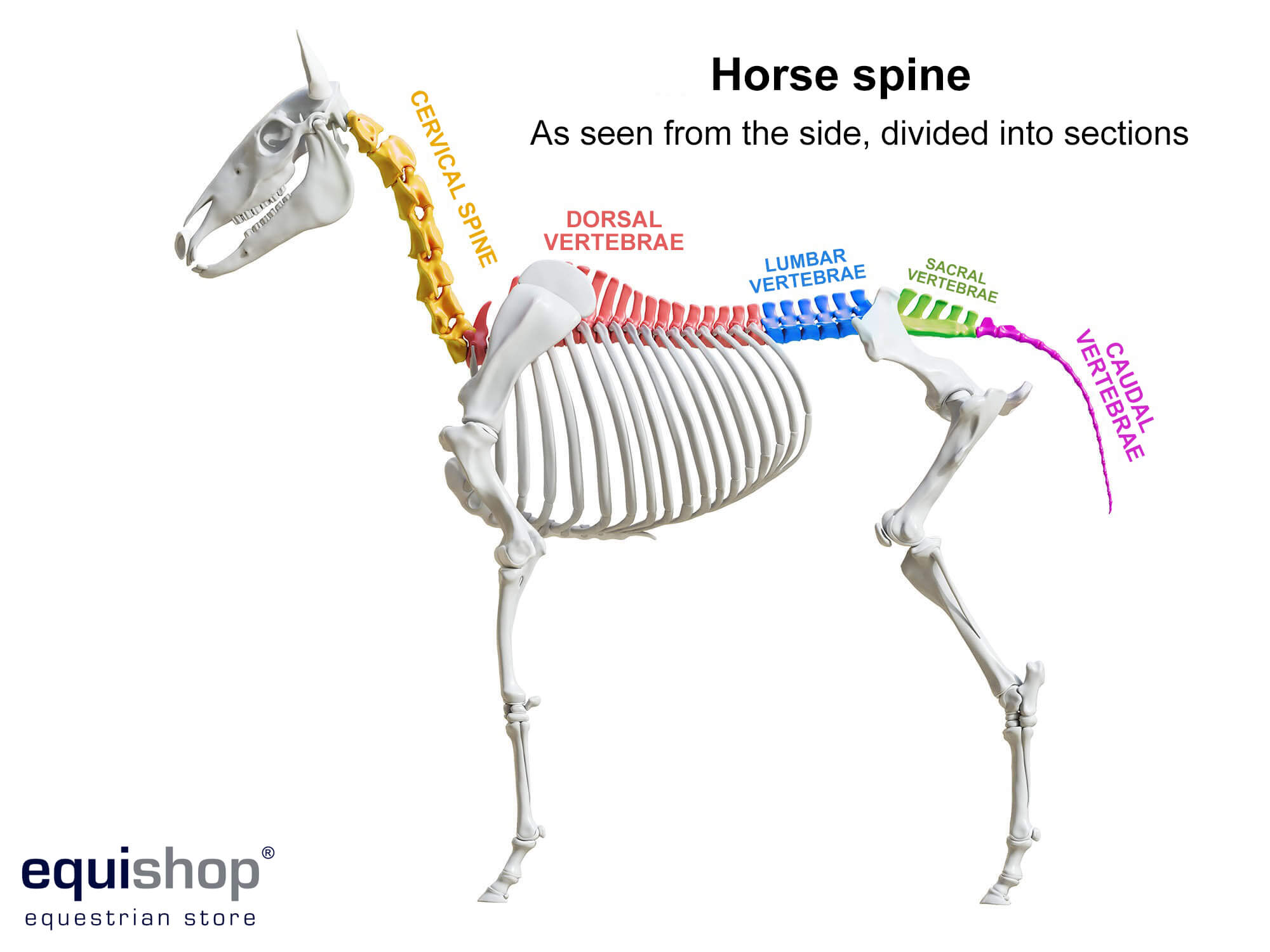
Within the vast tapestry of the animal kingdom, horses distinguish themselves with a skeletal architecture that showcases the pinnacle of evolutionary refinement. These calcified structures are specialized to meet the demands of their ecological niche, providing horses with endurance and resilience that are unrivaled among many species. This unique skeletal design is central to their role in diverse ecosystems and contributes to their long-standing partnership with humans.
Distinctive Density and Endurance of Horse Bones
Horses exhibit a bone density that is not only impressive but also a testament to their ability to endure the rigors of their active lifestyle. This formidable bone mass supports the weight and dynamic forces encountered during their powerful strides, contrasting with the lighter skeletal frames of smaller animals, which are optimized for different forms of maneuverability and energy-efficient movements.
Specialized Equine Cranial Features
The horse’s skull, a complex structure, is distinctively evolved to accommodate their herbivorous feeding habits. With a set of teeth specialized for grinding vegetation, the equine skull is markedly different from carnivorous species that possess sharp canines for tearing meat. Additionally, the capacious nasal cavities of horses are indicative of their high oxygen requirements during strenuous activities, a characteristic less prevalent in species with moderate respiratory needs.
Equine Vertebral Column: A Unique Design
The spinal configuration of horses is a marvel of evolutionary engineering. Its design, while providing impressive athletic capabilities through extended strides and shock absorption, differs from the vertebral structures of animals with sedentary or specialized lifestyles. The equine spine’s unique attributes allow for a range of movements that are essential for the horse’s speed and agility on varied terrains.
Biomechanical Excellence in Horse Limbs
The anatomy of equine limbs reflects a balance between robustness and precision, diverging from the functional adaptations seen in primates and subterranean mammals. The structural composition of the horse’s limbs, including segments like the cannon bones, is tailored for endurance and efficient movement across open plains, a necessity that is not as critical for arboreal or digging animals.
Divergence Between Equine and Avian Bone Structures
When horses are juxtaposed with birds, the differences in skeletal adaptations become even more pronounced. Unlike the lightweight, pneumatic bones of birds designed to facilitate flight, horse bones are dense, providing the necessary support for terrestrial speed and strength. These contrasting skeletal features underscore the distinct evolutionary paths taken by equines and avians to thrive in their respective environments.
Functionality of Horse Tail Anatomy
The equine tail, extending from the vertebral column, is often an underappreciated aspect of horse anatomy. It consists of coccygeal vertebrae and is integral to the horse’s ability to balance and communicate, serving functions that are not as pronounced in animals with less articulate tails.
Examining the skeletal system of horses in relation to other animals sheds light on the unique evolutionary adaptations that have enabled these creatures to become formidable partners in human endeavors. The resilience and strength of their bones are the result of millions of years of natural selection, equipping them to excel both as domesticated animals and in their wild habitats. This understanding inspires more informed approaches to their care and enhances our appreciation for these majestic beings.
Curious about the anatomy of horses? Beyond the skeletal mysteries answered in “How Many Bones Does A Horse Have,” there’s a lot more to discover. For instance, you might be intrigued to learn about their digestive system. Delve into the details by reading about how many stomachs a horse has. Or perhaps you’re interested in their extremities; in that case, find out how many toes a horse has. And for those curious about equine dental structures, our article on how many teeth horses have offers a comprehensive look into their impressive chompers. Explore these fascinating aspects to gain a deeper understanding of these majestic creatures.
FAQs about Horse Anatomy
Detailed Equine Bone Count and Horse Skeleton Facts
While the typical equine bone count hovers around 205 bones, the specific number can fluctuate slightly among different breeds. The horse’s ribcage, one of the largest structures in their skeleton, typically consists of 18 pairs of ribs, although this too can vary. Also of note is the horse’s heart, which weighs in at an impressive 9 pounds on average, underscoring the robustness of these animals.
Common Misconceptions About the Horse Skeletal System
Common misconceptions about the horse skeletal system may arise from a lack of knowledge about their unique anatomical adaptations. For instance, many may not realize that horse bones are solid rather than hollow, or that horses can’t physically express certain emotions as humans do because of their bone structure. Understanding these nuances can enhance our appreciation and care for these magnificent creatures.
In conclusion, the horse’s skeletal system is a testament to the evolutionary marvel that is the equine species. The number of bones in a horse, while averaging around 205, is just a starting point for understanding the intricate and powerful framework that allows these animals to run, jump, and carry humans into adventure and across fields. Whether you’re a rider, a veterinarian, or simply an equine enthusiast, the knowledge of equine anatomy is a fascinating journey into the world of these noble companions.



